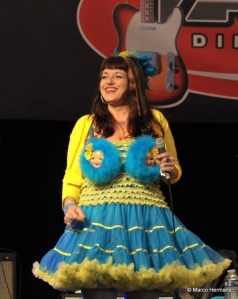leonard cohen koans

1h 15m
VENUE #15: Le Poisson Rouge
Performance seen: Tue 23 @ 7:15
Remaining performances: Fri 26 @ 8:30 Sat 27 @ 3
http://www.aliandthethieves.com
Rating: 8
(using the BroadwayWorld rating system of 10=effusive praise; 9=excellent; 7/8=positive with some reservations; 5/6=respectfully unenthused; 3/4=mostly negative; 2=little to recommend; 1=offended, insulted, angered)
If you were going to select an artist to create a show “built from our personal responses to the essences of the stories being told in his work,” in which “the arrangements cross genres and are interwoven with selections of his poetry and prose,” it’s hard to imagine a more likely oeuvre than that of that iconoclastic poet, songwriter, raconteur, singer, and occasional mystic, Leonard Cohen.
I’m a bit of a Leonard Cohen fan. I’ve watched the documentary “I’m Your Man,” several times. His two songs on k.d. lang’s “Hymns of the 49th Parallel” are my favorites. I can remember the first time I ever heard “Suzanne.” I have a favorite version of “Hallelujah” (Rufus Wainwright’s).
And most importantly for a prose writer like me, Cohen writes like a writer. Despite everything that Sondheim says about the differences between lyrics and poetry, Cohen’s lyrics read like poetry, and, more than any other kind of poetry, they read like prose poems.
Who else could represent freedom with the image of “a drunk in a midnight choir”? Or a woman’s hair as having been woven on a loom “of smoke and gold and breathing”? Who writes songs infused with Biblical references—Jesus walking on the water, David, Babylon, and a man weakened when a woman cuts his hair—and blowjobs?
For that matter, how many Jewish Canadian songwriter-poets have a Zen master? And I didn’t really know that much about Cohen’s poetry or his philosophy. I looked forward to a show that connected the many chain links of such an artist. It would be like fusing the theatrical existentialism of “The Flies” with the academic existentialism of “Being and Nothingness.” But with music!
Unfortunately, music is just about all there was. Twelve songs in 75 minutes. That doesn’t leave much room for Ali Hughes and her Thieves to “explore the work of Leonard Cohen, infusing his poetry, prose and song with their intricate, and very personal, elixir,” as the Fringe description promised.
The songs themselves were terrific, and Hughes and her musical director, pianist, and all-around collaborator, Daryl Wallis, have reached into the Cohen oeuvre to pull out a bunch of lesser-known works, including only a few favorites and ignoring some others.
Four songs in the show (Avalanche, Winter Lady, Lady Midnight, and Feels So Good)—fully one-third of the twelve-song playlist—are not among the 31 songs in the album “The Essential Leonard Cohen.” And going the other way, of the album’s five most popular songs, as judged by iTunes, two weren’t in the show (“Hallelujah” and “Everybody Knows”), nor is the other k.d. lang cover, “Bird on the Wire.”
(Here’s the complete song list, at least the night I attended, as best I could get them commited to notes: The Guests / Avalanche / Dance Me To The End Of Love / Chelsea Hotel No. 2 / Sisters Of Mercy / Winter Lady / Lady Midnight / Famous Blue Raincoat / I’m Your Man / Suzanne / Feels So Good / If It Be Your Will.)
The show was essentially a cabaret act with a veneer of Cohen as interstitial material. A Zen koan started and ended the show (a single koan, with a 70-minute cliffhanger), another koan was related, a few random Cohen quotes, and a couple of lines of “Hallelujah” made their way into “Feels So Good,” medley-style. Other than that, it was all songs, all the time. Even the song selection itself seemed to favor the love songs of a cabaret act, instead of the more story-oriented songs of a philosopher-poet.
The part of the show that perhaps best followed its description was the very center. Hughes told a koan about a couple that elope and, years later, return to the home of her disapproving parents. It was followed by two of the most story-like songs of the evening, “Winter Lady” (which seems to contradict the koan), and “Lady Midnight” (which reinforces the question of the koan).
Musically, “Suzanne” was by far the most interesting. I could imagine a hundred other singers singing most of the songs in much the same way Hughes did, but on “Suzanne” her voice snaked through the lyrics in unique ways, for example going up instead of down when bridging the two parts of the line, “all men will be sailors then until the sea shall free them.”
“I’m Your Man” was even more successful. Throughout, the musicians were exceptional and the two thieves (Marty Thomas and Chris Dilley) sang flawlessly, but for this number, all five elements of the music matched perfectly: the piano, bass, drums, backup singers, and lead vocal.
Hughes herself has a beautiful voice, and made a striking appearance. A tall 30something honey blonde woman, she wore a black dinner jacket with just a leotard or camisole barely showing itself underneath, black stretch pants, and black high-heeled open-toe bowtie patent leather pumps. I was disappointed in “Leonard Cohen Koans” as a Fringe show, but I would see her cabaret any time.
[more fringe 2011 reviews here]















